| Soft Centre 1 |
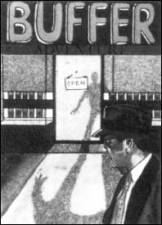
BUFFER MICRO has not strayed very far from home to find a setting for Buffer Adventure for the 48K Spectrum. It has used its shop as the major location, though if some parts of it are really as structurally unsound as they prove to be in the program, the staff had better take care. The adventure is pure text, designed on the Quill interpreter.
You must search through the shop network of apparently ruinous rooms for a credit card. When you find it you will naturally be able to buy all the electronic goodies you have always wanted. The crumbling emporium has a number of staff members around who, even if they are swinging from the chandeliers, may help or aggravate you in some way. A tip - watch for moody Mike, a dangerous chap to cross.
The program style is amusing and reasonably intricate in the difficulties to be overcome. If becoming severely puzzled is the sign of a reasonable adventure, this program meets that test. There is every chance you will be spending a long time working out what to do with a sheep. A sheep?
Richard Price
| BUFFER ADVENTURE | Memory: 48K | Price: £6.95 | Gilbert Factor: 6 |
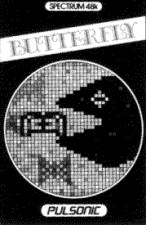
BUTTERFLY, from Pulsonic, is a simple game programmed entirely in Basic and consequently is rather slow when compared to other modern arcade games. You are a spider, chasing and catching a minimum of 12 butterflies per minute to survive.
The hazards of life on the windowsill are represented by the purple spider eater which lurks behind the curtains and who looks like an over-fed Pac-man. A joystick would help in raising the game from the level of mediocrity but unfortunately it is not designed to be joystick-compatible. Being in Basic, that could be remedied easily. Also the spider is a little slow to react and though it is possible to catch your prey, a good deal of practice would be necessary to enable you to catch the required 12.
Unfortunately, little attention has been paid to producing an interesting screen layout. The spider is fairly convincing but the butterflies are somewhat lacking in sparkle and the background is dull. Although the program costs only £1.99, it is what one would expect to find as a magazine listing, not as a commercial program.
John Lambert
| BUTTERFLY | Memory: 48K | Price: £1.99 | Gilbert Factor: 4 |
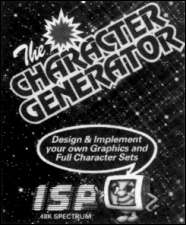
ONE OF the disadvantages of the Spectrum is that its character set, along with the built in UDGs are worthy but not particularly exciting for use in one's programs.
ISP has produced a program which, while it offers six sets of characters, allows you to design a full set from scratch, save it to tape and then put in your own program by using two simple POKEs to call it when required.
The Character Generator is a very user-friendly program, menu-driven, with good screen prompts and simple keyboard drills. It will appeal to even the most unconfident programmer as it produces impressive results quickly and easily.
Characters are defined by cursor movements on an 8 x 8 grid. With a full erase or fill capability, endless doodling and reshaping is possible. Individual characters can be displayed separately or you can view the full set. UDGs are defined in the same way.
In your programs, a set can be used in conjunction with the standard Sinclair face and can be switched in and out at will by two POKEs. The six sample sets vary in quality but the Gothic script is particularly impressive.
Richard Price
| CHARACTER GENERATOR | Memory: 48K | Price: £8.95 | Gilbert Factor: 8 |
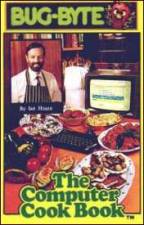
THE SPECTRUM dons a white hat and apron in a new program from Bug-Byte, The Computer Cookbook. The package comprises two cassettes, the first containing a menu planner and the second details of recipes.
IT is difficult to see how anyone would prefer loading a lengthy program to obtain a recipe rather than opening a cookbook but Bug-Byte thinks otherwise and employed a respected freelance chef, Ian Hoare, to provide a series of recipes for dishes both traditional and exotic.
The recipes are reasonably clear, if necessarily brief, given memory limitations. One useful feature is the facility to determine the correct quantities for any number of people up to 200.
The menu planner is of rather more interest, permitting you to choose a meal based on the size of your purse or the ingredients in your store cupboard.
When all is said and done the program remains a souped-up database.
Genuine cooks would do better to buy a general-purpose filing program and use it to store their favourite recipes.
Chris Bourne
| THE COMPUTER COOKBOOK | Memory: 48K | Price: £9.50 | Gilbert Factor: 5 |

DEFUSION and Worms are the latest K-Tel double offering. Defusion sets you the task of defusing bombs. You move Happy Larry along paths of blocks, avoiding static booby traps and collecting bonus-point flags.
The Hitman, a boot, chases Larry and will kill him if he can. The bombs also have a countdown timer which is shown on them. As Larry moves along the paths the green blocks are exhausted and he cannot return over them unless he moves the nearest path towards him.
The graphics are blocky and uninteresting and the movement is slow. There is a Pac-man-ish style about it but the concept is dated.
Worms, written apparently entirely in Basic, is a seven-screen game in which the player must manoeuvre the head of an ever-growing worm either to collect various objects or avoid others.
The graphics are simple UDG shapes, movement is slow, the idea is rather pedestrian. Little sense of involvement is possible, though very young players may derive some pleasure from it.
Richard Price
| DEFUSION/WORMS | Memory: 48K | Price: £5.95 | Joystick: Kempston | Gilbert Factor: 3 |
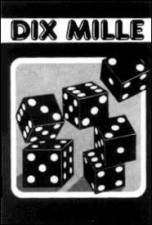
DIX MILLE, from CCS, is based on an old French dice game which is broadly similar to the English game of Poker Dice, although it uses six dice.
The principle is very simple. You throw the dice, various combinations are allotted scores, and you then decide which dice to retain, which to throw again, or whether to pass them to the next player.
It can be played by up to six players, of which the computer may or may not be one. The instructions on the cassette insert are not entirely clear but by playing with the computer for a few throws the process becomes simple.
The dice are portrayed graphically but that is the only graphic content to the game. Therefore the screen is not particularly attractive. It seems to be the kind of game which is better played with real dice; the computer adds nothing and even seems to take away some of the potential excitement.
The makers claim that it requires the "strategy of a Bridge player and the dash of a Poker player" - but it is a little difficult to see the game in those exalted terms.
John Lambert
| DIX MILLE | Memory: 48K | Price: £2.99 | Gilbert Factor: 5 |
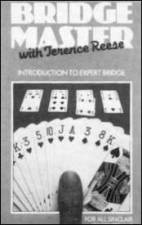
EXPERT Bridgemaster combines a computer program with a parallel audio cassette commentary to introduce those who already know a certain amount about the game to more expert play.
Terence Reese, bridge correspondent for The Observer and a player of international standing, acted as consultant in the preparation of the program. The tutor package uses 26 prepared deals which are loaded with the operating program and bases its play on the Acol bidding system.
It is possible to play each hand without the voice-over and then return to it to analyse the hand. Not all the hands are full hands, as some are used to demonstrate more advanced techniques like squeeze-play, cue bids, trump coups and the like. The computer will play the card automatically if required or alternatively you may play all the hands yourself.
A display of all hands is possible at any time and the hands can be restarted or re-dealt, though in the original form. There is no built-in print-out option. There is a bidding screen and a play screen.
Richard Price
| EXPERT BRIDGEMASTER | Memory: 16K | Price: £12.95 | Gilbert Factor: 7 |
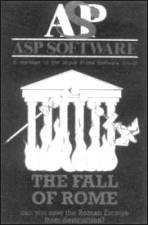
HISTORIAN Edward Gibbon in his book Decline and Fall of the Roman Empire reckoned it was Christianity which caused the end of the empire, corrupting the moral fibre of that warlike race. The Fall of Rome from ASP Software places the blame firmly on those hordes of Visigoths, Goths, Ostragoths, Huns, Saxons and countless other exotically-named barbarian tribes.
The Fall of Rome is a strategic war game in which you have to steer the vast empire through 60 years of fierce fighting as the barbarians march into your provinces. At the beginning of the game in 395BC you control the Mediterranean and most of southern Europe, from Britain in the west to Syria in the east. Your task is to survive for 12 turns of five years each and try to preserve as much of your empire as possible.
The mechanics are moderately simple for a war game. Each province generates an income which can be used to maintain permanent legions and raise new ones, as well as temporary units which disband at the end of a term. Units have offensive and defensive values and while some must remain in their province, others can be moved to a neighbouring province as reinforcements. The money can also be shifted and it is possible to use the order in which you deal with the provinces to transfer the cash a considerable distance through a chain of provinces.
When you have finished arranging your forces the computer takes a leisurely minute or two to generate the barbarian hordes, some of which appear to breed like flies. You then have the opportunity to fight.
The game is slow, much of it being written in Basic, and can become frustrating at times but requires much intelligent thought to play skilfully. There is one serious bug in the program; it is possible, if a province has become isolated, that there is nowhere where money can be transferred from that province. Unfortunately the program does not tell you at the time, so that if you try to transfer money you will be asked continually to transfer it somewhere else, with no possibility of escaping the loop. Perhaps ASP will clear the problem in future editions.
Bugs apart, the game appears to catch the flavour and likely events of the times reasonably accurately. All the provinces and tribes are given their Latin names, the map is clear, and the instructions adequate. We found that it is virtually impossible to retain Gaul and Illyria - modern France and Yugoslavia - for more than a few turns and, as happened eventually in history, the barbarians manage to capture Italy, leaving you to fight on in the east. At the end of the game you are given a rating based on the resources remaining.
In itself it is a fine game but its faults, which could so easily he rectified, make it unlikely to win too many converts.
Chris Bourne
| THE FALL OF ROME | Memory: 48K | Price: £6.99 | Gilbert Factor: 6 |
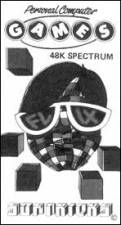
FLIX from Softricks is an attempt to reproduce one of those popular plastic puzzles in which the little squares have to be manipulated to re-form a scrambled picture. The picture is that well known image from Vogue of the woman in a blue dress created for the Spectrum by Print'n'Plotter.
There are four difficulty levels ranging from division of the picture into a 3 x 4 grid to 32 x 24. There is also the facility to LOAD your own picture for scrambling; two extra ones are provided. A third option is to attempt the competition in which the picture is already scrambled at the highest level of difficulty.
Softricks offers a Microvitec colour monitor with a Spectrum interface to the person who can solve the puzzle in the fewest number of moves. It is reasonably difficult to unscramble the picture at the easiest level. Overall, the game is very well-designed and fun to play, with easy-to-use controls.
John Lambert
| FLIX | Memory: 48K | Price: £5.95 | Gilbert Factor: 7 |